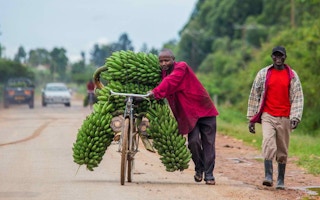In recent months climate change has been at the forefront of people’s minds. The Paris Agreement was a landmark in international discussions on how to tackle climate change and its effects. The recent Conference of the Parties (COP 22) in Marrakech shifted attention to its implementation, despite uncertainty around the incoming U.S. administration’s ongoing commitment to tackling climate change.
The Paris Agreement rightly recognises the links between climate change and poverty, as do the Sustainable Development Goals. Just under half of the global population living in extreme poverty is located in countries that are vulnerable to climate change.
And this is important, as people in poverty are more vulnerable than others to climate-related shocks such as floods, droughts, extreme weather events and increases in tropical diseases. Indeed, the impacts of climate change have the potential to cause those who have moved out of poverty to fall back into it when a natural disaster strikes.
Situations such as these often require an international humanitarian response, as some communities do not have the resilience levels to recover without assistance, and domestic governments often cannot finance the recovery in full either.
With climate change threatening to reverse the progress that has been made towards ending poverty, it is good news that in recent years international public resources to combat climate change have increased, with an estimated total of $48 billion flowing to developing countries in 2014.
Development finance institutions are increasing their support to climate projects, and the level of official development assistance targeted towards climate change is increasing. This finance is preventative by nature, pre-empting the devastating impacts of climate change and building resilience to them.
But how well are the links between climate change and poverty reflected in the distribution of those resources?
The answer is: not so well. In fact, international public finance aimed at adapting to the effects of climate change does not prioritise the countries - and so the people - that are most vulnerable to it. Some of the most vulnerable countries such as Eritrea, Guinea-Bissau, Sierra Leone and Liberia receive particularly little.
Countries with the highest vulnerability to climate change and the lowest domestic resources to build capacity to respond receive some of the smallest amounts. This pattern of distribution seems counter to common sense; surely finance aimed at adapting to the effects of this major threat should be prioritised to those most vulnerable to it, and those with the fewest resources of their own. Unfortunately several bottlenecks must be overcome if this situation is to be realised.
When it comes to resources to mitigate the impact of climate change, distribution seems more reasonable, as finance is distributed fairly proportionately against patterns of greenhouse gas emissions. However, support is lacking to a number of countries with significant needs and relatively few domestic resources to support them to adapt to the consequences of climate change.
These include the Democratic Republic of the Congo and Nigeria - two countries that are also home to high populations of people who are extremely poor.
Of course, much of this finance is not mandated to target those in poverty, but we do have the opportunity to create better synergies between actions to address climate change and efforts to end poverty.
“
Countries with the highest vulnerability to climate change and the lowest domestic resources to build capacity to respond receive some of the smallest amounts. This pattern of distribution seems counter to common sense.
To do this, resources aimed at adapting to the effects of climate change should be allocated in consideration of their impacts on the world’s poorest people. And mitigation strategies should be developed with an acute awareness of their impact on those populations.
Now the focus is on the implementation of both the Paris Agreement and the Sustainable Development Goals. To have the greatest impact these processes must happen in tandem and involve all countries.
At country level, nationally determined contributions and national development plans could identify overlaps of objectives and promote joint implementation strategies. International public climate finance to developing countries must be allocated swiftly, and after careful consideration of the impact on both agendas.
Climate finance can play a role in combating global poverty and preventing climate-related crises. In fact it is essential that it does, to avoid a reversal of progress and to prevent new forms of poverty from developing.
Harpinder Collacott is executive director at Development Initiatives. This report unpacks these issues further. This article is republishd from Thomson Reuters Foundation.











